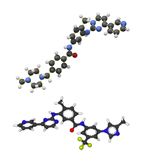Are CML Drugs Priced Out of Reach?
A group of experts say that cancer drug prices, especially those for chronic myeloid leukemia, have skyrocketed, making patient treatment extremely difficult.
An international group of experts say that the costs of cancer medications, and those used to treat chronic myeloid leukemia (CML) in particular, have skyrocketed to levels that make treating patients extremely difficult. The group published a perspective piece in the journal Blood online ahead of print on April 25.

Ball-and-stick models of the TKIs imatinib (top) and nilotinib (bottom)
“[We] believe the current prices of CML drugs are too high, unsustainable, may compromise access of needy patients to highly effective therapy, and are harmful to the sustainability of our national healthcare systems,” wrote the group, led by Hagop Kantarjian, MD, of MD Anderson Cancer Center in Houston. They noted that of the 12 drugs approved by the Food and Drug Administration (FDA) for various cancer indications in 2012, 11 were priced above $100,000 per year. A decade ago, the average cancer drug cost $5,000 per month, a number that has since doubled to more than $10,000 per month.
One issue with cancer drug prices is that they do not often reflect the amount of time the drug is likely to prolong survival. For example, a pancreatic cancer therapy that prolongs survival by 2 months could end up costing $400,000 per additional year lived. CML, according to the authors, is a very different case: the tyrosine kinases, led by imatinib’s introduction more than a decade ago, have proven to be astronomically successful drugs.
“With TKI therapy, the annual all-cause mortality in CML declined to 2%, versus a historical rate of 10%–20%, and the estimated 10-year survival increased from less than 20% to above 80%,” the authors wrote. Because of the success of these drugs, patients can live nearly normal life spans but pay extremely high premiums to do so.
“We believe that lowering the prices of CML drugs might improve accessibility to treatment and increase treatment adherence, effectively expanding the population of patients who live longer by continuing their TKI therapy,” said Dr. Kantarjian in a press release. The authors acknowledge that changing how cancer drugs are priced is an immensely complicated task, and will involve stakeholders, including the FDA and other regulators, pharmaceutical companies, patients, and many others. Among the group’s recommendations is to start holding regular meetings involving these parties to begin offering solutions for reduced cancer drug prices.
“Identifying better ways to manage the cost of cancer care will require an evolution in thinking about current pricing-related policies and regulations, including those that limit price negotiation for Medicare coverage of treatments, as well as patent-related laws that limit the introduction of more affordable generic drugs,” Dr. Kantarjian said.
Highlighting Insights From the Marginal Zone Lymphoma Workshop
Clinicians outline the significance of the MZL Workshop, where a gathering of international experts in the field discussed updates in the disease state.